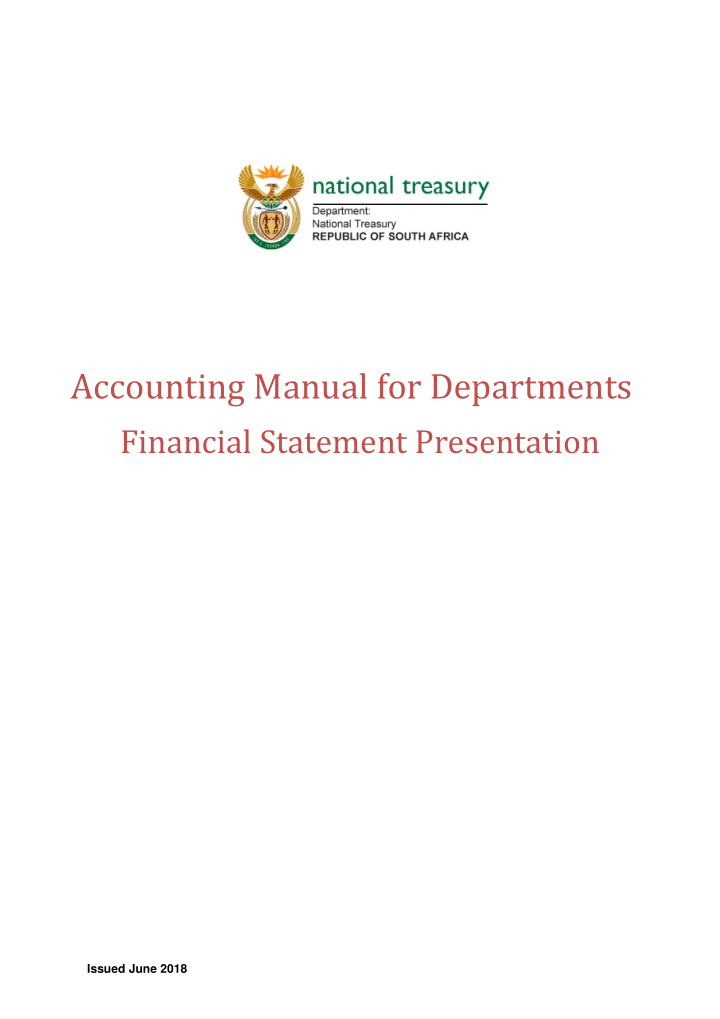



Accounting Manual for Departments Financial Statement Presentation Issued June 2018
Financial Statement Presentation Chapter Content 1 Overview ....................................................................................................................................... 3 2 Key Learning Objectives ............................................................................................................... 3 3 Financial Statement Presentation ................................................................................................. 4 3.1 Components of financial statements .................................................................................. 4 3.2 Primary and secondary financial information ..................................................................... 5 3.2.1 Primary financial information .......................................................................... 5 3.2.2 Secondary financial information ..................................................................... 5 3.3 Other presentation requirements ............................................................................. 6 3.3.1 Fair presentation .......................................................................................... 6 3.3.2 Going concern ............................................................................................. 7 3.3.3 Materiality and aggregation ............................................................................ 8 3.3.4 Consistency of presentation ........................................................................... 9 3.3.5 Offsetting .................................................................................................. 10 3.3.6 Comparative information ............................................................................. 11 3.3.7 Current vs. non-current distinction ................................................................ 11 4 Private Public Partnerships ......................................................................................................... 12 5 Summary of Key Principles ......................................................................................................... 14 5.1 Components of the financial statements ................................................................. 14 5.2 Primary and secondary financial information ........................................................... 14 5.3 Other presentation requirements ........................................................................... 14 5.4 Private Public Partnership .................................................................................... 14 Page 2 Issued June 2018
Financial Statement Presentation 1 Overview The purpose of this Chapter is to provide guidance on the presentation and disclosure of information in the financial statements. The Office of the Accountant-General has compiled a Modified Cash Standard (MCS) and this manual serves as an application guide to the MCS which should be used by departments in the preparation of their financial statements. Any reference to a “Chapter” in this document refers to the relevant chapter in the MCS and / or the corresponding chapter of the Accounting Manual. Explanation of images used in the manual: Definition Take note Management process and decision making Example 2 Key Learning Objectives Understanding the components of a complete set of financial statements Distinguish between primary and secondary financial information Understanding the presentation requirements that should be taken into account in preparing financial statements Page 3 Issued June 2018
Financial Statement Presentation 3 Financial Statement Presentation 3.1 Components of financial statements The financial results of a department consist of economic and service potential activities which are measured in two ways: the financial performance for a particular period, i.e. 1 April to 31 March the financial position at a particular point in time, i.e. 31 March both of which is supplemented with information disclosed in the notes The above information is presented in different components of the financial statements, which are: Appropriation statement The appropriation statement provides a summary of the financial performance of a department against its approved budget at a programme and sub-programme level. The preparation of the appropriation statement is discussed in detail in the Chapter 5 on Appropriation Statement . Statement of financial performance The statement of financial performance provides information of the inflow and outflow of funds over a given period of time and whether the department has made a surplus (revenue exceeds expenditure) or a deficit (expenditure exceeds revenue). Information presented in the statement of financial performance is the revenue earned and the expenditure incurred. Statement of financial position The state ment of financial position provides a snapshot of the department’s recognised assets and liabilities at a point in time. Information presented in the statement of financial position is the nature of assets, liabilities and net assets. Statement of changes in net assets The statement of changes in net assets provides a link between the statement of financial performance and the statement of financial position and explains movements in opening and closing balances. Cash flow statement The cash flow statement as the name suggests shows a summary of cash receipts and cash payments during the year. The preparation of a cash flow statement is discussed in detail in the Chapter 6 on Cash Flow Statements . Notes to the primary financial statements, including accounting policies The notes provide more detailed disclosure than is possible on the face of the financial statements (as referred to above). The notes to the financial statements include accounting policies which are fundamental to the understanding and interpretation of financial statements. Notes on secondary financial information The notes are provided on secondary financial information, for example contingent liabilities, commitments, accruals, movement in capital assets and provisions. There is a close relationship between the abovementioned components of financial statements. Each component reflects different aspects of the same transaction and/or event. Page 4 Issued June 2018
Financial Statement Presentation 3.2 Primary and secondary financial information 3.2.1 Primary financial information Primary financial information consists of recognised revenue, expenses, assets and liabilities presented in the financial statements. Primary financial information relates to items of revenue, expenses, assets, and liabilities that have been recognised in accordance with the recognition criteria established by the MCS and supplemented by guidance in the Accounting Manual. Financial statements presents primary financial information in the statement of financial position, statement of financial performance, statement of changes in net assets and other primary financial statements such as the appropriation statement, cash flow statement, and notes thereto. Examples of primary financial information include: Cash and cash equivalents Prepayments and advances Receivables Loans Compensation of employees Goods and services Interest and rent on land This Chapter prescribes the broad revenue and expenditure classification structure on the face of the statement of financial performance. The categories were introduced through the Reference Guide to the Economic Reporting Format (ERF). Further discussion and explanation on these can be found in the SCOA Classification Circular on Transfers and Subsidies versus Goods and Services or Capital Assets available on the SCOA website. 3.2.2 Secondary financial information Secondary financial information provides additional information about items of revenue, expenditure, assets and liabilities that have been recorded, but did not qualify for recognition in the primary financial statements. The criteria for recording and disclosing secondary financial information in the notes to the financial statements are established in the relevant Chapters of the MCS and supplemented by guidance in the Accounting Manual. Page 5 Issued June 2018
Recommend
More recommend